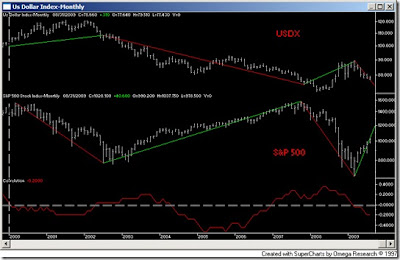As the graph above illustrates, a serious correlation between the US$ and the US equity markets has developed over the last 9+ years. This correlation is strong and for policy makers in Washington, rather disturbing. The relationship is as follows: If the US$ loses value the equity markets have rallied and if the US$ strengthens equity markets have sold off.
A hint as to the future direction of the US equity markets may reside in the chart above. If this strong correlation continues than any insight into the future strength or weakness of the Greenback could be helpful when managing a U.S. equity portfolio.
To that end, I offer the following story about the relationship between the US$ and the Japanese Yen. The Japanese economy has for years (decades in fact) been the poster child for failed socialist economic policies and as a result their interest rates have been the lowest of any major country in an effort to stimulate growth. Unfortunately, the socialist policies have overwhelmed the fiscal stimulus and a stagnation has resulted.
This stagnation has led to a very profitable trade for hedge funds over the years called the Yen carry trade. Simply put: with rates in Japan so low, an investor could borrow Yen, sell the Yen to buy the currency of another nation and use the currency to buy that nation’s government debt. As long as interest rates in that other nation were higher than in Japan the investor could profit on the spread between the cost to borrow Yen (tiny) and interest paid on the other nation’s debt (larger than tiny). Of course, a side effect of this trade would be the strengthening of the other nation’s currency and a major bid for said nation’s debt.
I believe the story below could be the proverbial “straw” that breaks the back of the US$. The US$ is fighting to maintain support above the crucial 80 level and avoid selling off to the lows of early 2008. The battle is in the process of being lost as the US$ sits at the 78 level as of this writing.
As the story below explains, the US$ is now cheaper to borrow than the Yen. The implications of this reversal could be enormous:
- A major leg of support for the US$ in the form of carry traders has vanished
- A major leg of support for the US treasury markets in the form of carry traders has vanished
- Could the carry trade begin to work in the reverse? Borrow and sell US$ to buy another nation’s currency and debt? This action, of course, would add even more pressure to a falling US$
The US$ is already under attack on many different fronts from increased government spending to seemingly endless treasury debt offerings to the Feds decision to monetize said debt. Will the loss of the carry trade support – or worse, a new reverse carry trade – lead to the real collapse in the US$? Only time will tell, but all signs point to trouble for the Greenback. This trouble could result in further upside for the equity markets as inflation becomes a reality and investors flee cash for high growth assets and commodities.
Dollar is now cheaper to borrow than yen – WSJ
WSJ reports the dollar officially became cheaper to borrow than the conspicuously low-yielding yen for the first time in more than 16 years. That doesn’t bode well for the U.S. currency, some analysts said.
The dollar has long benefited from positive yield premiums, especially against the Japanese currency, but the prospect of the Federal Reserve keeping U.S. overnight interest rates essentially at zero until at least late next year has wiped out the dollar’s premium. That means less incentive for investors to park funds in dollar assets for the relative yield advantage, or “carry.”
…We’re seeing another garbage rally unfold before us today in the most at-risk Financials, which began late yesterday afternoon with the massive short squeeze in AIG. This out-of-the-blue 5 point surge in AIG near 3pm ET yesterday wasn’t the result of a specific news-related catalyst; instead, it started as a small rally in the afternoon, and as it started to gather steam and accelerate it forced shorts to panic and scramble to cover.



One Response to US$/S&P 500 Correlation, Dollar Cheaper to Borrow Than the Yen, AIG Momentum Discussed